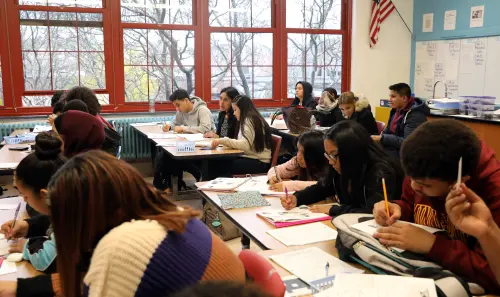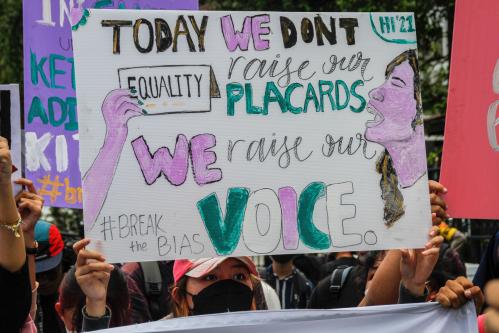This report was developed for our partners at Brookings Mountain West; the original version was published on their site on July 9, 2021.
Abstract
Public K-12 education serves as a launching pad for economic mobility and opportunity, preparing students for college or a good-paying job. Despite K-12 education’s influence on later-in-life outcomes, schools often underserve students of color. Hispanic students in particular constitute a significant and growing portion of the U.S. student population yet are often overlooked in education literature because they are not the lowest performing demographic. In this brief, we examine how well public K-12 education serves Hispanic students in Clark County, where nearly half of students are Hispanic. We then consider factors that may influence student performance, including both in-school factors and family background, and conclude by recommending paths to improve educational outcomes for Hispanic students in Clark County and beyond.
- Introduction
- Wide race gaps in Clark County student outcomes
- Why teachers matter
- The lack of teacher diversity in Clark County
- Outside the classroom
- Policy implications
- Conclusion
Introduction
With regard to age, race, and ethnicity, the Las Vegas-Henderson-Paradise, NV metropolitan statistical area (MSA) looks today the way the U.S. is expected to look by 2060.1 The Las Vegas metro already has a large Hispanic population, especially in younger age cohorts.2 The demographics of the Las Vegas public school district reflects similar trends. The Clark County School District (CCSD) is the 5th largest school district in the nation, and Hispanic students make up 47% of CCSD students, compared to 27% of students in the U.S.3 By 2060, the Hispanic population is projected to constitute over a quarter of the U.S. population.4 But Hispanic students are often overlooked in education discussions, perhaps in part because they are not the lowest-performing demographic.
A quality K-12 education can provide students with an opportunity to move up the economic ladder by gaining skills to work or attend college. Yet race and ethnic gaps in academic performance remain large, and Hispanic students are often underserved by their schools, contributing to lower educational attainment and lower wages compared to their peers.5 Given that the CCSD Hispanic student population has grown to make up nearly half of all CCSD students in just a few decades, CCSD can provide a valuable lens to investigate the performance of Hispanic students. We also need to better understand how the education system can adapt to the realities of the student body it serves.
COVID-19 only served to exacerbate race and ethnic gaps in education. In March 2020, Nevada Governor Steve Sisolak halted CCSD’s in-person instruction with an emergency order that remained in effect until the following spring. But a student’s success in a remote learning environment is influenced by their family’s resources — like income, educational attainment, and housing access (among many others) — which cut starkly across race and ethnicity.6 Racial and ethnic disparities in education are not new, but the pandemic raises the stakes.
To that end, in this piece we:
- describe how Hispanic students in Clark County are faring compared to their peers, as well as to Hispanic students in the U.S. as a whole;
- examine the role teachers and schools play in shaping student outcomes, especially for students of color;
- explore students’ family background by race and ethnicity in Clark County; and
- propose potential policy reforms to better serve Hispanic or Latino students and their families.
Our focus on Hispanic outcomes is not intended to imply that the disparity between their outcomes and others, especially white students, is the widest, or the most important: as our results show, that is not the case. Our goal is simply to consider the specific educational outcomes and experience of Hispanic students with an eye to potential policies that may help this group.
wide race gaps in clark county student outcomes
We focus first on test scores in elementary and middle school, on-time high school graduation, college readiness scores, and college enrollment rates. From 3rd to 8th grade, Clark County School District (CCSD) students take statewide Criterion-Referenced Tests (CRTs), which are designed to assess whether a student is on track for “college and career readiness.” Long before high school, stark race gaps in proficiency rates emerge. In the 2018-2019 school year, fewer than half of CCSD students were considered “proficient” in English Language Arts and fewer than 40% were considered proficient in mathematics.7 Although proficiency has increased over the last several years, the county falls short of satisfactory rates — especially for students of color.8 Figure 1 shows the portion of 3rd to 8th grade CCSD students who were considered proficient according to their CRT results in the 2018-19 school year. White and Asian students outperform their peers by a significant margin.9
CCSD student performance on the National Assessment of Educational Progress (NAEP), a nationally representative assessment of student performance, also provides evidence of low performance compared to national rates and stark race gaps. In 2019, 24% of 8th grade CCSD students were considered proficient in math compared to 34% of U.S. students. Just over a quarter (27%) of 8th grade CCSD students were considered proficient in reading compared to 34% of 8th graders across the nation.10 At the state level, race gaps are clear: In 2019, 35% of Nevada’s 8th grade white students were considered proficient in reading, compared to 21% of Hispanic students and 14% of Black students.11 Similarly, 26% of Nevada’s white 8th grade students were considered proficient in math, compared with 14% of Hispanic students and 8% of Black students.12
These gaps through middle school are echoed in high school graduation rates. To compare CCSD graduation rates with typical rates in the U.S., we use the 4-year adjusted cohort graduation rate (ACGR), which measures the portion of students who graduate among those who began their freshman year four years earlier. In 2018, of Clark County students who started ninth grade four years earlier, 85% graduated from high school — about on par with the overall U.S. rate.13
But the high school graduation rate differs significantly by race and ethnicity within Clark County – and these gaps differ somewhat from the national pattern. Asian or Pacific Islander CCSD students graduate at the highest rate among CCSD students (94%), similar to the U.S. rate among Asian or Pacific Islander students (93%).14 Hispanic students graduate at a slightly higher rate in CCSD than the U.S. average (84% compared to 82%). But Black students in Clark County graduate at a lower rate (76%) than the average CCSD student and at a lower rate than the average U.S. Black student (80%). White CCSD students graduate at the same rate as white students across the U.S. (89%).
High school students in CCSD are also less likely to be prepared for higher education than the average U.S. student.15 Figure 2 shows the share of CCSD students who received a proficient Mathematics score on the ACT and the share who received a proficient English Language Arts score by race or ethnicity; fewer than a quarter of the District’s students received a proficient math score and fewer than half received a proficient English Language Arts score.
The gaps up to and through high school are reflected in college enrollment rates. Half (49%) of CCSD’s high school graduating class of 2018 went on to enroll in college in the fall after graduating high school. To estimate the portion of 2014-15 CCSD high school freshmen who enrolled in college right after high school graduation, we use Nevada Department of Education high school graduation rates and National Student Clearinghouse college enrollment estimates.16 Here again, racial and ethnic gaps are apparent; Asian and white high school graduates enroll in college at a noticeably higher rate than Hispanic or Black students. About 37% of Hispanic or Latino 9th graders enrolled in college four years later, compared to 33% of Black students, 51% of white students, and 64% of Asian students.
Figure 3 shows the share of 9th graders who graduate high school, the share of high school graduates who enroll in college, and the share of students entering the University of Nevada, Las Vegas (UNLV) who graduate within 6 years (85% of UNLV students are Nevada residents, many of whom attended K-12 in CCSD).17 The fall enrollment metric represents the portion of high school graduates who enroll in any college right after high school and the UNLV graduation rate represents the portion of full-time, first-time, degree-seeking enrollees who finish their program within 150% of normal time. But it is important to note that not all CCSD high school graduates who enroll in college attend UNLV. Because it is likely that enrollment rates at any given institution differ by race, tracking UNLV graduation alone does not entirely reflect postsecondary completion rates.
The overall picture is of a school district struggling to equip its students for college or a career, especially for students of color. Of course, Clark County is hardly alone in this regard, and it has begun taking action to remediate these gaps.18 But there is clearly more work to be done to promote racial equity in education. While the U.S. will come to look like Clark County in terms of racial demographics, clearly it would be a massive policy failure if it also looked like Clark County in terms of its current educational outcomes.
Investing in teachers and students saves public money in the long run. Not only do students with higher levels of educational attainment earn more money and have better health, but education also produces a sizable public benefit: High school graduates are substantially less likely than dropouts to draw on public resources via Medicaid, unemployment benefits, or the criminal justice system.19 Researchers estimate that every dollar spent on improving educational attainment returns between $1.45 to $3.55.20 Over a graduate’s lifetime, that can stack up to a taxpayer benefit of about $127,000.
In the sections that follow, we discuss the resources and approaches that local governments, state governments, and school districts could use to better serve Hispanic or Latino students.
why teachers matter
Educational outcomes reflect and reinforce racial inequities in a wide range of other domains, including employment, income, housing, wealth, health and many more.21 As Robert Putnam writes in Our Kids: “The American public school today is as a kind of echo chamber in which the advantages or disadvantages that children bring with them to school have effects on other kids… schools as sites probably widen the class gap.”22 Much the same could be said of racial gaps too. But as Putnam argues, while schools are not, by and large, the leading cause of these inequities, they have an important role to play in addressing them.
There are many aspects of schooling conditions that contribute to racial and ethnic achievement gaps. Here we focus on the role of teachers, and the importance of teacher diversity for Hispanic students.23
Teachers are the “single most important school-based factor” influencing student achievement. When students have high value-added teachers (based on student test score improvement), they are more likely to attend college, earn higher wages, and are less likely to become a parent in their teens.24 And when students — especially Black boys from low-income families — have teachers who look like them, they perform better.25 There are a few reasons this could be the case. First, a teacher can be an invaluable role model, especially when students see themselves as similar to their teacher in terms of race, ethnicity, and gender.26 Second, researchers find that teachers of color are more likely to have high expectations for students of color. Third, teachers may be better able to relate to their students when they share similar cultural and social experiences. (Importantly, research also shows that white students also benefit from racially and ethnically diverse teachers).27
Hispanic teachers in particular play an important role in Hispanic students’ academic outcomes. One study shows that a 10% increase in the share of Hispanic teachers in an elementary school is associated with a 3% increase in Hispanic participation in gifted programs.28Our Brookings colleague Diana Quintero also finds that schools with a higher share of Hispanic teachers have a higher share of Hispanic students taking Advanced Placement (AP) classes.29 While not necessarily causal, these studies are consistent with the hypothesis that Hispanic teachers may have higher expectations for Hispanic students or are better able to support their learning.
The lack of teacher diversity in clark county
While only 22% of students are white in Clark County schools, two-thirds of CCSD teachers are white — that works out to about six white students per white teacher.30 Meanwhile, for every Hispanic or Latino teacher, there are 64 Hispanic or Latino CCSD students. Figure 4 shows the number of students for every teacher of the same race or ethnicity in CCSD. As our colleagues Michael Hansen and Diana Quintero found, teacher diversity in the Mountain West region lags behind the U.S. Hispanic teachers are the most underrepresented in the profession, especially in Clark County.31
It is worth noting that the current generation of K-12 students is more racially diverse than older generations (especially among those who have a 4-year degree), so it would be especially difficult to hire a teaching force that is completely representative of its students. But even accounting for generational demographic differences, there are far fewer Hispanic or Latino teachers per student.32
The School District has long been aware of its growing diversity problem.33 In July 2019, Superintendent Jesus Jara created a commission to advise progress on student equity and access. The commission’s January 2020 report emphasized improving opportunity for students of color, and diversifying programs like Gifted and Talented Education, advanced course placements, and AP course enrollment.34
But the report makes no mention of teachers, nor of teacher diversity (though their teacher shortage report a year later does).35 As we discussed above, the share of Hispanic teachers is positively correlated with the share of Hispanic students in advanced courses. To the extent CCSD is interested in improving diversity in those courses, they should also focus on improving diversity among teachers. On top of the District’s teacher diversity problem, the District is also facing a severe teacher shortage. According to its January 2021 report, more than ten percent of the District’s teachers resign after their first year of teaching.36 Research shows that teachers of color are more likely to leave the profession than their white counterparts.37 Retaining CCSD teachers of color, then, should be one of the District’s top priorities.
Teacher turnover is especially high in schools that serve disproportionately low-income students of color — which are also more likely to be staffed by teachers of color. Although, it is important to note that turnover in low-income schools is much higher among white teachers than it is among teachers of color. Attrition among teachers of color is explained almost entirely by poor working conditions.38 Teachers of color often report feeling hyper-surveilled by their administrators or isolated from their coworkers, especially in predominantly white schools.39 In a meta-analysis of teacher training and retention, our colleagues found some evidence that bonuses and teacher collaboration can improve retention.40 CCSD’s January report highlights the need to improve the District’s culture — but there needs to be an explicit commitment to improving the work culture for teaching staff of color.
In addition to its plan to improve retention, the District is also making an effort to improve recruitment. But recruiting teachers of color is subject to a chicken and egg problem; students have better academic achievement when their teachers look like them, but achievement gaps also make it more difficult to hire teachers of color. As it stands, Hispanic and Black students graduate high school at a lower rate, enroll in college at a lower rate, and graduate college at a lower rate. Part of the solution to better serving students of color includes hiring Hispanic and Black teachers. Doing so will require deliberate intervention at the university level and exploring non-traditional paths to certify educators.
One such university-level project at UNLV, Abriendo Caminos (“Opening Pathways”), aims to recruit college students of color, improve CCSD’s teacher diversity, and address Southern Nevada’s teacher shortage.41 The program especially hopes to increase the number of Hispanic or Latino UNLV students who will go on to teach in CCSD. In addition to improving teacher diversity, addressing CCSD’s teacher shortage at a local university may also help improve retention because potential teachers already have strong ties to their community.
With proper investment, the School District’s current plan to increase alternate teacher certification capacity is likely to increase the number of certified teachers of color. Alternate certification programs typically enroll a larger share of students of color — especially Hispanic students — which would increase the number of qualified potential teachers.42
Outside the classroom
As the quote from Robert Putnam above highlights, school outcomes reflect inequalities in broader society, including the resources that parents can bring to bear. Citizenship status, income, educational attainment, English proficiency, and control over when and where to work all matter. School districts should invest resources to improve student outcomes, but an important goal of public policy is to help set parents and families up for success.
In this section, we explore five factors influencing the resources available to parents in Clark County, especially Hispanic parents. This is by no means an exhaustive list; many other important out-of-school factors influence student outcomes. (Our colleagues explore many of these topics in Las Vegas — housing, health, etc. — in other work with Brookings Mountain West and The Lincy Institute).43 Our goal is to highlight existing inequities in a few major areas that policymakers should keep in mind when creating education and family-focused policy.
Parents’ education
Even accounting for socioeconomic status, children’s IQ, childhood behavior, and children’s aspirations in adolescence, parental education significantly predicts children’s educational attainment, and economic success as much as 40 years later.44 Educational attainment creates a feedback loop; children with highly-educated parents are more likely to pursue higher education themselves.
The parents of students enrolled in CCSD public schools are significantly less educated than the average U.S. parent; only about a fifth of parents have a bachelor’s degree or higher, compared to a third of U.S. parents.45 Similarly, 46% of CCSD parents have a high school degree or less, compared to 36% of U.S. parents (see Figure 5). We also expect educational attainment to differ significantly by race in Clark County, which could further compound disadvantages for K-12 students of color.
Income
Unsurprisingly, family incomes of students in Clark County public schools are also lower than for the average U.S. student — $64,000 a year (median) compared to $71,000.46 Hispanic CCSD students have lower average family income than other students in the District, but have similar family incomes to the U.S. average Hispanic student: $51,000 and $50,000, respectively.
Food security
Food insecurity can damage children’s mental health, physical health, and their performance in school. A 2021 analysis shows that when schools offer free meals to all students, they perform better compared to areas which apply an income-based qualification.47
At the start of the pandemic, food insecurity skyrocketed; over 16% of households with children reported that it was “sometimes or often the case that children were not eating enough due to a lack of resources” in June 2020.48 A large majority of CCSD students were eligible for free or reduced school lunch in the 2020-21 school year, and those students are disproportionately likely to be Hispanic or Latino based on average family income and the 2019 food insecurity rates among children.49
The National School Lunch Program, which provides federally funded meals at schools to qualifying children, improves health outcomes and reduces food insecurity among low-income children.50 Over the summer, there are many fewer locations where families are able to get free meals for their children, with many families citing transportation as an obstacle; the national summer meals program reaches only 16% of students who need it.51
Language
Learning starts before students enroll at their first public school, but learning in a language other than English at a young age can lead some students to fall behind at English-speaking schools. One in four CCSD parents speak English less than “very well” at home, compared to one in seven of parents across the U.S.52 Students who start school with lower levels of English proficiency sometimes have a harder time catching up. The average English language learning (ELL) student has lower academic achievement compared to the average non-ELL student, and needs to be better connected to opportunities to learn at school. In 2021, CCSD began to discuss a dual language program designed to improve emerging multilingual students’ learning experience.53 Being multilingual has many benefits, and policymakers can continue to help the third of CCSD students who speak another language — many of whom are Hispanic — capitalize on their skills.54
Immigration status
Immigrant parents in Las Vegas — who are disproportionately likely to be Hispanic or Latino — face unique obstacles. Nearly a quarter (23%) of CCSD parents are not U.S. citizens, compared to 13% of parents across the U.S.55 In addition to facing language barriers, high poverty rates, and family separation, undocumented Latino immigrants report worse access to health care and face additional immigration-related stress.56 Because children are greatly impacted by family instability, income, and stress, immigration policy can therefore impact immigrant students’ academic performance.57
Although several metropolitan areas have significantly larger populations than Las Vegas, the Las Vegas metro still has the 13th largest unauthorized immigrant population in the U.S.58As a result, Las Vegas has the highest share of unauthorized immigrants among U.S. metro areas, making up over 8% of its total population. That share becomes more dramatic when considering K-12 parents; a 2019 Pew report shows that one in five Nevada students has a parent who is an unauthorized immigrant, well over twice that of the national average (7.6%).59 Figure 6 shows the five states with the highest and lowest shares of K-12 students with an unauthorized immigrant parent in 2016 compared to the national average.
Work schedule unpredictability
Workers often face last-minute schedule changes, which can make it difficult for them to schedule the rest of their lives. Because work in Clark County is centered around entertainment and tourism, workers face especially unpredictable work schedules, which is a particular challenge for parents who need time to arrange childcare.
To estimate the portion of Clark County workers who experience unpredictable scheduling, we combined the share of parents in each industry from American Community Survey estimates with Bureau of Labor Statistics work scheduling data.60 Assuming that national patterns hold for the same industries in Clark County, CCSD parents are 19% more likely than the average U.S. parent to learn their work schedule two weeks or less in advance (42% of CCSD parents compared to 35% of U.S. parents).
Policy implications
The challenges facing Hispanic students in Clark County echo those of many students across the U.S. and can be addressed — at least in part — through federal policymaking. But many will need to be addressed at the local level. Here, we explore some ways to improve the educational outcomes of Hispanic or Latino students, especially in the Las Vegas Valley:
- Recruit and retain diverse teachers. CCSD should increase investment in recruiting and retaining teachers of color, and universities should improve diversity among those preparing to teach, perhaps by offering financial aid and robust career assistance. Some private donors could create a scholarship program for underrepresented groups that offers recipients a substantial student loan to be forgiven if they teach in a public school for at least two years.61 UNLV and the Nevada Department of Education should continue to invest in existing programs to recruit diverse education majors.
In addition to its current efforts to address workplace culture, the District should also consider: (1) offering “differentiated professional development” for teachers of color to network and access continuing education opportunities, and (2) creating more inclusive environments in schools with predominantly white teaching staff.62
- Improve food security. The federal government could increase the maximum Supplemental Nutrition Assistance Program (SNAP) benefit.63 State and local governments could also invest more in food security programs, potentially by giving families an electronic benefit transfer (EBT) to purchase meals (especially over the summer). Some schools and districts with at least 40% of students qualifying for other assistance (like SNAP) have started offering free meals to all students, which improves food security and eases the administrative burden on schools and school districts.64 School districts could also expand summer meal flexibility, perhaps through creating more food pickup locations as CCSD has done during the pandemic, or by providing students who rely on school buses during the year with transportation to food sites.65 The Biden administration is working to extend and expand food programs for students, especially during the summer, but until sufficient federal action is taken, local and state governments should prioritize student food security.66
- Devote additional resources to close the remote-learning gap. Some researchers suggest offering summer school, while others consider the benefits of afterschool programs that target learning gaps.67 Both have the potential to improve student learning outcomes and may give working parents (especially those with unpredictable schedules) more flexibility. Schools may also consider supplementing instruction with high-quality tutoring during school, after school, or in the summer.68
- Shape family-friendly immigration policy. As suggested by the Anne E. Casey Foundation, education and child welfare should be weighed heavily in the shaping of immigration policy – for example, by keeping families together when making decisions about the immigration status of parents. More help could also be provided to immigrant students. Lowering language barriers would help students access programs like Head Start — a federal program designed to expand educational opportunities for young low-income children. Policymakers should emphasize communicating public food assistance, workforce development, housing assistance, and other public program eligibility to immigrant parents.69
- Promote fair scheduling. Unpredictable work schedules make it challenging for employees to schedule the rest of their lives, which is particularly difficult for parents who need to arrange childcare. Requiring employers to pay workers for schedule changes made within 14 days’ notice, as proposed by Senator Warren, is one promising approach towards incentivizing employers to give workers more predictable schedules.70
Conclusion
Only 31% of respondents to a 2015 nationally-representative study considered closing the Hispanic-white educational achievement gap to be “essential” or a “high priority” — lower levels of support than for closing the gap between Black and white students, or between affluent and poor students.71 But given the stark racial disparities shown here, it is clear that improving K-12 education for Hispanic students should be an important goal for policymakers, and especially in school districts like Clark County, where almost half of students are Hispanic. Public K-12 education serves as a launching pad for economic mobility and opportunity, preparing students for college or a good-paying job. As the U.S. becomes an increasingly race-plural society, providing better opportunities to Hispanic or Latino students will be central to the success of our educational system overall.72
-
Acknowledgements and disclosures
Special thanks to UNLV Director of Brookings Mountain West, William E. Brown, Jr., and to Director of Strategic Development at Brookings Mountain West, Dr. Caitlin J. Saladino, for their input. Thanks also to Ashley LeClair, Brookings Mountain West, who provided valuable editing and design expertise in the final production of this report. Special thanks to Brookings Mountain West and The Lincy Institute student researchers Guadalupe De La Rosa, Marie Falcone, and Peter Grema for their assistance with reviewing the final document.
-
Footnotes
-
Jed Kolko, “40 Years From Now, The U.S. Could Look Like Las Vegas.” FiveThirtyEight, June 2017 (fivethirtyeight.com/features/40-years-from-now-the-u-s-could-look-like-las-vegas/);
William F. Frey, “The US will become ‘minority white’ in 2045, Census projects.” The Brookings Institution, March 2018 (brookings-edu-2023.go-vip.net/blog/the-avenue/2018/03/14/the-us-will-become-minority-white-in-2045-census-projects/). - American Community Survey 2019 1-year estimates, “ Sex by age (Hispanic or Latino).” U.S. Census Bureau, Table B01001I, 2019 (data.census.gov).
-
Nevada Accountability Portal, “Demographic Profile.” Nevada Department of Education, 2019-2020 school year (nevadareportcard.nv.gov);
National Center for Education Statistics, “Enrollment and percentage distribution of enrollment in public elementary and secondary schools, by race/ethnicity and region: Selected years, fall 1995 through fall 2029.” Institute for Education Sciences, Table 203.50, reference year: 2019 (nces.ed.gov/programs/digest/d20/tables/dt20_203.50.asp?current=yes) - Jonathan Vespa, Lauren Medina, & David M. Armstrong, “Demographic Turning Points for the United States: Population Projections for 2020 to 2060.” U.S. Census Bureau, March 2018 (www.census.gov/content/dam/Census/library/publications/2020/demo/p25-1144.pdf).
-
American Community Survey 2019 5-year estimates, “Educational Attainment.” U.S. Census Bureau, Table S2501, 2019 (data.census.gov);
U.S Bureau of Labor Statistics, “Labor force characteristics by race and ethnicity, 2019.” Report 1088, December 2020 (www.bls.gov/opub/reports/race-and-ethnicity/2019/home.htm). - Faith Mitchell, “COVID-19’s Disproportionate Effects on Children of Color Will Challenge the Next Generation.” Urban Institute, August 2020 (www.urban.org/urban-wire/covid-19s-disproportionate-effects-children-color-will-challenge-next-generation).
- Nevada Accountability Portal, “Group Summary Report; CRT (New NV Standards), Year 2018-2019.” Nevada Department of Education (nevadareportcard.nv.gov).
- Nevada Accountability Portal, “Group Summary Report; CRT (New NV Standards).” Nevada Department of Education, school years 2015-2019 (nevadareportcard.nv.gov).
- Nevada Department of Education documentation doesn’t explicitly address whether racial categories include Hispanic people of that race. Because documentation (nevadareportcard.nv.gov/DI/MoreDownload?filename=2018%20NSPF%20Procedures%20Manual.pdf) includes a student ethnicity variable that seems to allow one selection, we expect that reported racial categories (e.g., “white” or “Black”) refer to non-Hispanic people of that race.
- The Nation’s Report Card, “District Profiles; Clark County (NV).” Performance on the National Assessment of Educational Progress (NAEP) in 2019. (www.nationsreportcard.gov/profiles/districtprofile/overview/XX?cti=PgTab_Findings&chort=1&sub= MAT&sj=XX&fs=Grade&s t=MN&year=2019R3&sg=Gender%3A+Male+vs.+Female&sgv=Difference&ts=Single+Year&sfj=NL); The Nation’s Report Card, “Results from the 2019 Mathematics and Reading Assessments.” 2020 (www.nationsreportcard.gov/mathematics/supportive_files/2019_infographic.pdf).
- Nevada Accountability Portal, “National Assessment of Educational Progress, Reading, Grade 8, 2019.” Nevada Department of Education, 2019 (nevadareportcard.nv.gov/di/main/naep).
- Nevada Accountability Portal, “National Assessment of Educational Progress, Mathematics, Grade 8, 2019.” Nevada Department of Education, 2019 (nevadareportcard.nv.gov/di/main/naep).
-
Nevada Accountability Portal, “Group Summary Report; Cohort 4Yr Graduation Rates (Reported for Prior School Year).” Nevada Department of Education, accountability year 2018-2019 (nevadareportcard.nv.gov);
National Center for Education Statistics, “Public high school 4-year adjusted cohort graduation rate (ACGR), by selected student characteristics and state: 2010-11 through 2017-18.” Institute for Education Sciences, Table 219.46, reference year: 2018-2019 (nces.ed.gov/programs/digest/d20/tables/dt20_219.46.asp) - Authors calculated the combined Asian and Pacific Islander CCSD graduation rate for comparison to US totals.
-
All Nevada high school students take the ACT; Nevada Accountability Portal, “Group Summary Report; ACT.” Nevada Department of Education, school year 2019-2020 (nevadareportcard.nv.gov);
ACT, “ACT Profile Report – National: Graduating Class 2020.” 2020 (www.act.org/content/dam/act/unsecured/documents/2020/2020-National-ACT-Profile-Report.pdf) -
Nevada Accountability Portal, “Group Summary Report; Cohort 4Yr Graduation Rates (Reported for Prior School Year).” Nevada Department of Education, accountability year 2018-2019 (nevadareportcard.nv.gov);
Jackie Valley, “New data shows how many Clark County graduates head to college, highlights challenges.” The Nevada Independent, reporting National Student Clearinghouse data, September, 2019 (thenevadaindependent.com/article/new-data-shows-how-many-clark-county-graduates-head-to-college-but-also-highlights-some-challenges). - University of Nevada, Las Vegas, “Facts and Stats.” (www.unlv.edu/about/facts-stats).
- Clark County School District, “Focus: 2024: Clark County School District’s Five-Year Strategic Plan.” February, 2019 (newsroom.ccsd.net/wp-content/uploads/2019/02/Focus-2024.pdf).
-
Elka Torpey, “Education Pays.” U.S.Bureau of Labor Statistics, February, 2019 (www.bls.gov/careeroutlook/2019/data-on-display/education_pays.htm);
Robert A. Hahn and Benedict I. Truman, “Education Improves Public Health and Promotes Health Equity,” International Journal of Health Services, 2015;45(4):657-678. doi:10.1177/0020731415585986. - Henry M. Levin and Cecilia E. Rouse, “The True Cost of High School Dropouts.” The New York Times, January 2012 (www.nytimes.com/2012/01/26/opinion/the-true-cost-of-high-school-dropouts.html).
-
Ryan Nunn, Jana Parsons, and Jay Shambaugh, “Race and underemployment in the U.S. labor market.” The Brookings Institution, August, 2019 (brookings-edu-2023.go-vip.net/blog/up-front/2019/08/01/race-and-underemployment-in-the-u-s-labor-market/);
Brookings Institution, “Real median household income varies by race and Hispanic origin.” 2016 (brookings-edu-2023.go-vip.net/?simplechart=real-median-household-income-varies-by-race-and-hispanic-origin);
Jenny Schuetz, “Rethinking homeownership incentives to improve household financial security and shrink the racial wealth gap.” The Brookings Institution, December 2020 (brookings-edu-2023.go-vip.net/research/rethinking-homeownership-incentives-to-improve-household-financial-security-and-shrink-the-racial-wealth-gap/);
Michaela Broyles, “A conversation about the racial wealth gap—and how to address it.” The Brookings Institution, June 2019 (brookings-edu-2023.go-vip.net/blog/brookings-now/2019/06/18/a-conversation-about-the-racial-wealth-gap-and-how-to-address-it/);
Dayna Bowen Matthew, Edward Rodrigue, and Richard Reeves, “Time for justice: Tackling race inequalities in health and housing.” The Brookings Institution, October 2016 (brookings-edu-2023.go-vip.net/research/time-for-justice-tackling-race-inequalities-in-health-and-housing/). - Robert D. Putnam, “Our Kids: The American Dream in Crisis.” Simon & Schuster Paperbacks, 2016, page 182.
- Katrina Liu, Shaoan Zhang, Chelsea Desalvo, and Malayka Cornejo, “Recruit, Pr Recruit, Prepare, and Retain Teachers of Color in Nevada.” Policy Issues in Nevada Education 1-19 (digitalscholarship.unlv.edu/co_educ_policy/4/)
-
Tuan D. Nguyen and Matthew G. Springer, “Reviewing the evidence on teacher attrition and retention.” The Brookings Institution, December 2019 (brookings-edu-2023.go-vip.net/blog/brown-center-chalkboard/2019/12/04/reviewing-the-evidence-on-teacher-attrition-and-retention/);
Raj Chetty, John N. Friedman, and Jonah E. Rockoff, “Measuring the Impacts of Teachers II: Teacher Value-Added and Student Outcomes in Adulthood.” American Economic Review, 104 (9): 2633-79. DOI: 10.1257/aer.104.9.2633. -
Seth Gershenson, Cassandra M. D. Hart, Joshua Hyman, Constance Lindsay and Nicholas W. Papageorge, “The Long-Run Impacts of Same-Race Teachers.” National Bureau of Economic Research, November 2018. DOI: 10.3386/w25254;
Anna J. Egalite, Brian Kisida, and Marcus A. Winters, “Representation in the classroom: The effect of own-race teachers on student achievement.” Economics of Education Review, April 2015; 45:44-52 (doi.org/10.1016/j.econedurev.2015.01.007). - Dan Goldhaber, Roddy Theobald, Christopher Tien, “The Theoretical and Empirical Arguments for Diversifying the Teacher Workforce: A Review of the Evidence.” Center for Education Data & Research, 2015 (www.cedr.us/working-papers).
- Amy Stuart Wells, Lauren Fox, and Diana Cordova-Cobo, “How Racially Diverse Schools and Classrooms Can Benefit All Students.” The Century Foundation, February 2016 (tcf.org/content/report/how-racially-diverse-schools-and-classrooms-can-benefit-all-students/?agreed=1&session=1&agreed=1&session=1).
- Jason A. Grissom, Luis A. Rodriguez, and Emily C. Kern, “Teacher and Principal Diversity and the Representation of Students of Color in Gifted Programs: Evidence from National Data.” The Elementary School Journal, 2017 117(3): 396-422 (www.journals.uchicago.edu/doi/abs/10.1086/690274).
- Diana Quintero, “The benefits of Hispanic student-teacher matching for AP courses.” The Brookings Institution, October 2019 (brookings-edu-2023.go-vip.net/blog/brown-center-chalkboard/2019/10/11/the-benefits-of-hispanic-student-teacher-matching-for-ap-courses/).
-
Clark County School District, “2020-2021 Validation Day Ethnicity Report.” 2020 (dzg.ccsd.net/wp-content/uploads/2021/01/2021-Ethnicity-Reoprt-with-cover-and-chart.pdf);
Clark County School District, “5-Year Clark County School District Employee Ethnic Distribution Comparison by Work Location.” October 2020 (ccsd.net/resources/human-resources-division/employee-groups-5-yr-ethnicity-comparison-10-01-20.pdf). - Michael Hansen and Diana Quintero, “The Growing Need for Diverse Teachers in the Mountain West.” Brookings Mountain West, December 2018 (digitalscholarship.unlv.edu/brookings_pubs/51).
- Michael Hansen and Diana Quintero, “4 ways to measure diversity among public school teachers.” The Brookings Institution, November 2017 (brookings-edu-2023.go-vip.net/blog/brown-center-chalkboard/2017/11/17/four-ways-to-measure-diversity-among-public-school-teachers/).
- Paul Takahashi, “‘Teacher diversity gap’ cause for concern in CCSD schools.” Las Vegas Sun, November 2012 (lasvegassun.com/news/2012/nov/25/district-laggin/).
- Clark County School District Superintendent’s Student Equity and Access Commission, “Achieving Equity and Access in the Clark County School District.” CCSD, January 2020 (newsroom.ccsd.net/wp-content/uploads/CCSD-Student-Equity-and-Access-Commission-Report_FINAL-PRINT-SM.pdf).
- Clark County School District Superintendent’s Teacher Recruitment and Retention Commission, “Ending the Teacher Shortage in Clark County.” CCSD, January 2021 (newsroom.ccsd.net/wp-content/uploads/CCSD-Teacher-Recruitment-and-Retention-Commission-Report_12021.pdf).
- Clark County School District Superintendent’s Teacher Recruitment and Retention Commission, “Ending the Teacher Shortage in Clark County.” CCSD, January 2021 (newsroom.ccsd.net/wp-content/uploads/CCSD-Teacher-Recruitment-and-Retention-Commission-Report_12021.pdf).
-
Richard Ingersoll and Henry May, “Recruitment, Retention and the Minority Teacher Shortage.” Consortium for Policy Research in Education. CPRE Research Report #RR-69, 2011 (repository.upenn.edu/cgi/viewcontent.cgi?referer=&httpsredir=1&article=1232&context=gse_pubs);
Yolanda Sealey-Ruiz and Chance W. Lewis, “Guest Editorial: Transforming the Field of Education to Serve the Needs of the Black Community: Implications for Critical Stakeholders.” Journal of Negro Education, 2011 (www.jstor.org/stable/41341125). - Nicole S. Simon and Susan Moore Johnson, “Teacher Turnover in High-Poverty Schools: What We Know and Can Do.” Teachers College Record Volume 117 Number 3, 2015, p. 1-36 (www.tcrecord.org/Content.asp?ContentId=17810).
- Valerie Strauss, “Black male teachers: There aren’t enough of them.” Washington Post, April 2015 (www.washingtonpost.com/news/answer-sheet/wp/2015/04/28/black-male-teachers-there-arent-enough-of-them/).
- Tuan D. Nguyen and Matthew G. Springer, “Reviewing the evidence on teacher attrition and retention.” The Brookings Institution, December 2019 (brookings-edu-2023.go-vip.net/blog/brown-center-chalkboard/2019/12/04/reviewing-the-evidence-on-teacher-attrition-and-retention/).
- Abriendo Caminos, University of Nevada, Las Vegas College of Education (http://mesame.us/).
- Jessica Yin and Lisette Partelow, “An Overview of the Teacher Alternative Certification Sector Outside of Higher Education.” Center for American Progress, December 2020 (www.americanprogress.org/issues/education-k-12/reports/2020/12/07/480408/overview-teacher-alternative-certification-sector-outside-higher-education/).
- Brookings Mountain West, Policy Briefs, see www.unlv.edu/brookingsmtnwest/policy-briefs.
- Eric F. Dubow, Paul Boxer, and L. Rowell Huesmann, “Long-term Effects of Parents’ Education on Children’s Educational and Occupational Success: Mediation by Family Interactions, Child Aggression, and Teenage Aspirations.” Merrill-Palmer quarterly (Wayne State University. Press), 55(3), 224–249. https://doi.org/10.1353/mpq.0.0030.
- Education Demographic and Geographic Estimates, “Table [PDP02.5] Educational Attainment.” National Center for Education Statistics, American Community Survey 2014-18 (nces.ed.gov/programs/edge/TableViewer/acsProfile/2018).
- Education Demographic and Geographic Estimates, “Table [CDP03] Selected Economic Characteristics of Children.” National Center for Education Statistics, American Community Survey 2014-18 (nces.ed.gov/programs/edge/TableViewer/acsProfile/2018).
- Krista Ruffini, “Schoolwide free-meal programs fuel better classroom outcomes for students.” The Brookings Institution, February 2021 (brookings-edu-2023.go-vip.net/blog/brown-center-chalkboard/2021/02/11/schoolwide-free-meal-programs-fuel-better-classroom-outcomes-for-students/).
- Lauren Bauer, “About 14 million children in the U.S.are not getting enough to eat.” The Brookings Institution, July 2020 (brookings-edu-2023.go-vip.net/blog/up-front/2020/07/09/about-14-million-children-in-the-us-are-not-getting-enough-to-eat/).
-
State of Nevada Department of Education, “Enrollment for Nevada Public Schools,” 2020-21 (doe.nv.gov/DataCenter/Enrollment/);
Economic Research Service, “Food Security in the U.S.: Interactive Charts and Highlights.” U.S. Department of Agriculture, September 2020 (www.ers.usda.gov/topics/food-nutrition-assistance/food-security-in-the-us/interactive-charts-and-highlights/). - Craig Gundersen, Brent Kreider, and John Pepper, “The impact of the National School Lunch Program on child health: A nonparametric bounds analysis.” Journal of Econometrics, 2011; DOI: 10.1016/j.jeconom.2011.06.007.
- No Kid Hungry, “Facts About Child Hunger in America.” (www.nokidhungry.org/who-we-are/hunger-facts).
- Education Demographic and Geographic Estimates, “[PDP02] Selected Social Characteristics of Parents in the United States.” National Center for Education Statistics, American Community Survey 2014-18 (nces.ed.gov/programs/edge/TableViewer/acsProfile/2018).
- Jackie Valley, “Clark County School District proposes dual language program, drawing skepticism about sustainability.” The Nevada Independent, June 11, 2021 (thenevadaindependent.com/article/clark-county-school-district-proposes-dual-language-program-drawing-skepticism-about-sustainability).
- Education Demographic and Geographic Estimates, “[CDP02] Selected Social Characteristics of Children in the United States.” National Center for Education Statistics, American Community Survey 2014-18 (nces.ed.gov/programs/edge/TableViewer/acsProfile/2018).
- Education Demographic and Geographic Estimates, “[PDP02] Selected Social Characteristics of Parents in the United States.” National Center for Education Statistics, American Community Survey 2014-18 (nces.ed.gov/programs/edge/TableViewer/acsProfile/2018).
-
Omar Martinez, Elwin Wu, Theo Sandfort, Brian Dodge, Alex Carballo-Dieguez, Rogeiro Pinto, Scott D. Rhodes, Eva Moya, and Silvia Chavez-Baray, “Evaluating the Impact of Immigration Policies on Health Status Among Undocumented Immigrants: A Systematic Review.” J Immigr Minor Health. 2015 Jun; 17(3): 947–970. doi: 10.1007/s10903-013-9968-4;
Rosa Maria Sternberg, Anna Maria Nápoles, Steven Gregorich, Steven Paul, Kathryn A. Lee, and Anita L. Stewart, “Development of the Stress of Immigration Survey (SOIS): a Field Test among Mexican Immigrant Women.” Fam Community Health. 2016 Jan-Mar; 39(1): 40–52. doi: 10.1097/FCH.0000000000000088. - The Annie E. Casey Foundation, “Race for Results.” 2017 (assets.aecf.org/m/resourcedoc/aecf-2017raceforresults-2017.pdf).
- Jeffrey S. Passel and D’vera Cohn, “20 metro areas are home to six-in-ten unauthorized immigrants in U.S.” Pew Research Center, March 2019 (www.pewresearch.org/fact-tank/2019/03/11/us-metro-areas-unauthorized-immigrants/).
- Pew Research Center, “U.S. unauthorized immigrant population estimates by state, 2016.” February 2019 (www.pewresearch.org/hispanic/interactives/u-s-unauthorized-immigrants-by-state/).
-
Education Demographic and Geographic Estimates, “Selected Economic Characteristics of Parents.” National Center for Education Statistics, American Community Survey 2014-18 (nces.ed.gov/programs/edge/TableViewer/acsProfile/2018);
U.S.Bureau of Labor Statistics, “Table 5. How far in advance workers knew their work schedules by selected characteristics, averages for the period 2017-2018.” 2019 (www.bls.gov/news.release/flex2.t05.htm). - Katy Reckdahl, “Training More Black Men to Become Teachers.” The Atlantic, December 2015 (www.theatlantic.com/education/archive/2015/12/programs-teachers-african-american-men/420306/).
- Valerie Strauss, “Black male teachers: There aren’t enough of them.” Washington Post.
- Hilary Hoynes and Diane Whitmore Schazenbach, “Strengthening SNAP as an Automatic Stabilizer.” The Hamilton Project, May 2019 (www.hamiltonproject.org/papers/strengthening_snap_as_an_automatic_stabilizer).
- Krista Ruffini, “Schoolwide free-meal programs fuel better classroom outcomes for students.” The Brookings Institution, February 2021 (brookings-edu-2023.go-vip.net/blog/brown-center-chalkboard/2021/02/11/schoolwide-free-meal-programs-fuel-better-classroom-outcomes-for-students/).
- Kristyn Leonard, “Districts work hard to adapt nutrition programs for online learning, but many children still face barriers to access.” The Nevada Independent, August 2020 (thenevadaindependent.com/article/districts-work-hard-to-adapt-nutrition-programs-for-online-learning-but-many-children-still-face-barriers-to-access).
- Carmen Reinicke, ”Biden Proposal will make free school lunch available to 29 million children every summer.” CNBC, May 2021 (www.cnbc.com/2021/05/05/biden-plan-will-make-free-meals-available-to-children-every-summer.html).
-
Douglas N. Harris, “Using federal stimulus to get schools through the coronavirus crisis: The case for summer school and summer teacher pay.” The Brookings Institution, March 2020 (brookings-edu-2023.go-vip.net/blog/brown-center-chalkboard/2020/03/11/using-federal-stimulus-to-get-schools-through-the-coronavirus-crisis-the-case-for-summer-school-and-summer-teacher-pay/);
National Conference of State Legislatures, “Supporting Student Success Through Afterschool Programs.” 2021 (www.ncsl.org/research/education/expanding-learning-opportunities-through-afterschool-programs.aspx). - Brown University “Initiative aims to create high-impact tutoring programs at schools across the U.S.” (www.brown.edu/news/2021-03-04/accelerator).
-
The Annie E. Casey Foundation, “Race for Results.” 2017 (assets.aecf.org/m/resourcedoc/aecf-2017raceforresults-2017.pdf);
Hamutal Bernstein, Cary Lou, Wesley Jenkins, “Policymakers Can Prioritize Better Ways to Support Children of Immigrants through Housing Assistance.” Urban Institute, January 2021 (www.urban.org/urban-wire/policymakers-can-prioritize-better-ways-support-children-immigrants-through-housing-assistance);
Marcela Montes and Vickie Choitz, “Improving Immigrant Access to Workforce Services: Partnerships, Practices & Policies.” The Aspen Institute, July 2016 (www.aspeninstitute.org/wp-content/uploads/2016/09/Improving-Immigrant-Access-to-Workforce-Services.pdf). - Elizabeth Warren, “Schedules That Work Act.” S.3256, 116th Congress, 1st Session (www.congress.gov/bill/116th-congress/senate-bill/3256?q=%7B%22search%22%3A%5B%22%5C%22schedules+that+work+act%5C%22%22%5D%7D&s=3&r=2).
- Jon Valant and Daniel A. Newark, “The Politics of Achievement Gaps: U.S. Public Opinion on Race-Based and Wealth-Based Differences in Test Scores.” Educational Researcher, Vol. 45 No. 6, pp. 331–346, DOI: 10.3102/0013189X16658447.
- Richard V. Reeves and Camille Busette, “The middle class is becoming race-plural, just like the rest of America.” The Brookings Institution, February 2018 (brookings-edu-2023.go-vip.net/blog/social-mobility-memos/2018/02/27/the-middle-class-is-becoming-race-plural-just-like-the-rest-of-america/).
-
Jed Kolko, “40 Years From Now, The U.S. Could Look Like Las Vegas.” FiveThirtyEight, June 2017 (fivethirtyeight.com/features/40-years-from-now-the-u-s-could-look-like-las-vegas/);
William F. Frey, “The US will become ‘minority white’ in 2045, Census projects.” The Brookings Institution, March 2018 (brookings-edu-2023.go-vip.net/blog/the-avenue/2018/03/14/the-us-will-become-minority-white-in-2045-census-projects/).
National Center for Education Statistics, “Enrollment and percentage distribution of enrollment in public elementary and secondary schools, by race/ethnicity and region: Selected years, fall 1995 through fall 2029.” Institute for Education Sciences, Table 203.50, reference year: 2019 (nces.ed.gov/programs/digest/d20/tables/dt20_203.50.asp?current=yes)
U.S Bureau of Labor Statistics, “Labor force characteristics by race and ethnicity, 2019.” Report 1088, December 2020 (www.bls.gov/opub/reports/race-and-ethnicity/2019/home.htm).
National Center for Education Statistics, “Public high school 4-year adjusted cohort graduation rate (ACGR), by selected student characteristics and state: 2010-11 through 2017-18.” Institute for Education Sciences, Table 219.46, reference year: 2018-2019 (nces.ed.gov/programs/digest/d20/tables/dt20_219.46.asp)
ACT, “ACT Profile Report – National: Graduating Class 2020.” 2020 (www.act.org/content/dam/act/unsecured/documents/2020/2020-National-ACT-Profile-Report.pdf)
Jackie Valley, “New data shows how many Clark County graduates head to college, highlights challenges.” The Nevada Independent, reporting National Student Clearinghouse data, September, 2019 (thenevadaindependent.com/article/new-data-shows-how-many-clark-county-graduates-head-to-college-but-also-highlights-some-challenges).
Robert A. Hahn and Benedict I. Truman, “Education Improves Public Health and Promotes Health Equity,” International Journal of Health Services, 2015;45(4):657-678. doi:10.1177/0020731415585986.
Brookings Institution, “Real median household income varies by race and Hispanic origin.” 2016 (brookings-edu-2023.go-vip.net/?simplechart=real-median-household-income-varies-by-race-and-hispanic-origin);
Jenny Schuetz, “Rethinking homeownership incentives to improve household financial security and shrink the racial wealth gap.” The Brookings Institution, December 2020 (brookings-edu-2023.go-vip.net/research/rethinking-homeownership-incentives-to-improve-household-financial-security-and-shrink-the-racial-wealth-gap/);
Michaela Broyles, “A conversation about the racial wealth gap—and how to address it.” The Brookings Institution, June 2019 (brookings-edu-2023.go-vip.net/blog/brookings-now/2019/06/18/a-conversation-about-the-racial-wealth-gap-and-how-to-address-it/);
Dayna Bowen Matthew, Edward Rodrigue, and Richard Reeves, “Time for justice: Tackling race inequalities in health and housing.” The Brookings Institution, October 2016 (brookings-edu-2023.go-vip.net/research/time-for-justice-tackling-race-inequalities-in-health-and-housing/).
Raj Chetty, John N. Friedman, and Jonah E. Rockoff, “Measuring the Impacts of Teachers II: Teacher Value-Added and Student Outcomes in Adulthood.” American Economic Review, 104 (9): 2633-79. DOI: 10.1257/aer.104.9.2633.
Anna J. Egalite, Brian Kisida, and Marcus A. Winters, “Representation in the classroom: The effect of own-race teachers on student achievement.” Economics of Education Review, April 2015; 45:44-52 (doi.org/10.1016/j.econedurev.2015.01.007).
Clark County School District, “5-Year Clark County School District Employee Ethnic Distribution Comparison by Work Location.” October 2020 (ccsd.net/resources/human-resources-division/employee-groups-5-yr-ethnicity-comparison-10-01-20.pdf).
Yolanda Sealey-Ruiz and Chance W. Lewis, “Guest Editorial: Transforming the Field of Education to Serve the Needs of the Black Community: Implications for Critical Stakeholders.” Journal of Negro Education, 2011 (www.jstor.org/stable/41341125).
Economic Research Service, “Food Security in the U.S.: Interactive Charts and Highlights.” U.S. Department of Agriculture, September 2020 (www.ers.usda.gov/topics/food-nutrition-assistance/food-security-in-the-us/interactive-charts-and-highlights/).
Rosa Maria Sternberg, Anna Maria Nápoles, Steven Gregorich, Steven Paul, Kathryn A. Lee, and Anita L. Stewart, “Development of the Stress of Immigration Survey (SOIS): a Field Test among Mexican Immigrant Women.” Fam Community Health. 2016 Jan-Mar; 39(1): 40–52. doi: 10.1097/FCH.0000000000000088.
U.S.Bureau of Labor Statistics, “Table 5. How far in advance workers knew their work schedules by selected characteristics, averages for the period 2017-2018.” 2019 (www.bls.gov/news.release/flex2.t05.htm).
National Conference of State Legislatures, “Supporting Student Success Through Afterschool Programs.” 2021 (www.ncsl.org/research/education/expanding-learning-opportunities-through-afterschool-programs.aspx).
Hamutal Bernstein, Cary Lou, Wesley Jenkins, “Policymakers Can Prioritize Better Ways to Support Children of Immigrants through Housing Assistance.” Urban Institute, January 2021 (www.urban.org/urban-wire/policymakers-can-prioritize-better-ways-support-children-immigrants-through-housing-assistance);
Marcela Montes and Vickie Choitz, “Improving Immigrant Access to Workforce Services: Partnerships, Practices & Policies.” The Aspen Institute, July 2016 (www.aspeninstitute.org/wp-content/uploads/2016/09/Improving-Immigrant-Access-to-Workforce-Services.pdf).
The Brookings Institution is committed to quality, independence, and impact.
We are supported by a diverse array of funders. In line with our values and policies, each Brookings publication represents the sole views of its author(s).








